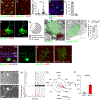Perivascular neurons instruct 3D vascular lattice formation via neurovascular contact
- PMID: 38733989
- PMCID: PMC11223890
- DOI: 10.1016/j.cell.2024.04.010
Perivascular neurons instruct 3D vascular lattice formation via neurovascular contact
Abstract
The vasculature of the central nervous system is a 3D lattice composed of laminar vascular beds interconnected by penetrating vessels. The mechanisms controlling 3D lattice network formation remain largely unknown. Combining viral labeling, genetic marking, and single-cell profiling in the mouse retina, we discovered a perivascular neuronal subset, annotated as Fam19a4/Nts-positive retinal ganglion cells (Fam19a4/Nts-RGCs), directly contacting the vasculature with perisomatic endfeet. Developmental ablation of Fam19a4/Nts-RGCs led to disoriented growth of penetrating vessels near the ganglion cell layer (GCL), leading to a disorganized 3D vascular lattice. We identified enriched PIEZO2 expression in Fam19a4/Nts-RGCs. Piezo2 loss from all retinal neurons or Fam19a4/Nts-RGCs abolished the direct neurovascular contacts and phenocopied the Fam19a4/Nts-RGC ablation deficits. The defective vascular structure led to reduced capillary perfusion and sensitized the retina to ischemic insults. Furthermore, we uncovered a Piezo2-dependent perivascular granule cell subset for cerebellar vascular patterning, indicating neuronal Piezo2-dependent 3D vascular patterning in the brain.
Keywords: Piezo2; ischemic optic neuropathy; perivascular neurons; retinal ganglion cells; three-dimensional vascular architecture; vascular lattice formation; vascular perfusions.
Copyright © 2024 Elsevier Inc. All rights reserved.
Conflict of interest statement
Declaration of interests J.Z. and X.Y. are employees of Genentech/Roche. J.K. is listed as an inventor on Boehringer Ingelheim’s patent (AAV-BR1, #10696717).
Figures







References
MeSH terms
Substances
Grants and funding
LinkOut - more resources
Full Text Sources
Molecular Biology Databases
Research Materials

